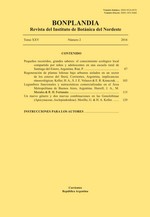Regeneración de plantas leñosas bajo arbustos aislados en un sector de los esteros del Iberá, Corrientes, Argentina, implicancias etnoecológicas.
DOI:
https://doi.org/10.30972/bon.2521260Palabras clave:
Esteros, Ilex dumosa, ka’a mirĩ, plantas nodrizas, selva incipiente, sucesión leñosaResumen
Macrosistema Iberá. El objetivo fue evaluar el efecto nodriza de los arbustos y los parámetros estructurales de la regeneración. Se demostró que la presencia de arbustos aislados es determinante en el establecimiento de regeneración y que Ilex dumosa var. guaranina, Ocotea lancifolia y Miconia chamissois promovieron significativamente la abundancia y riqueza de los mismos. La regeneración estuvo compuesta por 21 especies pero principalmente estructurada por Miconia chamissois, Ilex dumosa var. guaranina, Citronella gongonha y Myrsine parvula. Los resultados indican además que Ilex dumosa var. guaranina fue la especie solitaria más abundante, y una de las que mejor regeneran en estas condiciones. Considerando que estos arbustos pueden llegar a constituir el estado inicial en la formación de fragmentos de selva más o menos grandes, se sugiere que el atributo de abundancia de esta especie en este tipo de sucesión leñosa primaria guarda relación con la expresión “ka’a mirĩ” (la selva incipiente), un nombre guaraní de Ilex dumosa var. guaranina.Descargas
Los datos de descargas todavía no están disponibles.
Descargas
Publicado
2016-07-01
Cómo citar
Keller, H. A., Velazco, S. J. E., & Krauczuk, E. R. (2016). Regeneración de plantas leñosas bajo arbustos aislados en un sector de los esteros del Iberá, Corrientes, Argentina, implicancias etnoecológicas. Bonplandia, 25(2), 103–114. https://doi.org/10.30972/bon.2521260
Número
Sección
Artículos originales
Licencia
Declaration of Adhesion to Open Access
- All contents of Bonplandia journal are available online, open to all and for free, before they are printed.
Copyright Notice
- Bonplandia magazine allows authors to retain their copyright without restrictions.
- The journal is under a Creative Commons Attribution 4.0 International license.















.jpg)


